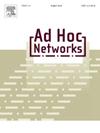无人机网络中协同通信、传感和计算的联合功率最小化和轨迹设计
IF 4.4
3区 计算机科学
Q1 COMPUTER SCIENCE, INFORMATION SYSTEMS
引用次数: 0
摘要
在本文中,我们提出了一种由无人机辅助的协作通信、传感和计算(CCSC)模型。地面用户(GUs)生成计算任务并与无人机通信,以确定任务是否可以在本地处理或卸载给无人机。虽然GUs的计算能力有限,但无人机可以处理更复杂的任务并感知目标状态。多天线基站不仅要管理与无人机的通信任务,而且要调度无人机的作战任务和分配计算任务。研究了基于通信感知和计算的无人机弹道设计与功率最小化问题。由于问题是非凸的,因此采用分块坐标下降法单独求解原问题。为了解决功率最小化问题,提出了一种基于交换匹配的卸载决策算法,解决任务卸载问题,使无人机的计算、悬停和飞行功率最小化。针对无人机的轨迹设计,提出了一种基于逐次凸逼近(SCA)的无人机轨迹设计算法来优化无人机的轨迹。仿真结果表明,该算法优于贪婪算法和遗传算法等基准算法。本文章由计算机程序翻译,如有差异,请以英文原文为准。
Joint power minimization and trajectory design for collaborative communication, sensing, and computing in UAV networks
In this paper, we propose a collaborative communication, sensing, and computing (CCSC) model assisted by unmanned aerial vehicles (UAVs). Ground users (GUs) generate computing tasks and communicate with UAVs to determine whether the tasks can be processed locally or offloaded to the UAVs. While GUs have limited computing power, UAVs are equipped to handle more complex tasks and sense target states. The multi-antenna base station (BS) not only manages communication tasks with UAVs but also schedules UAV operations and assigns computational tasks. The problem of UAV trajectory design and power minimization based on communication sensing and computing is studied. Since the problem is non-convex, the original problem is solved separately by a block coordinate descent approach. To solve the power minimization problem, we propose an offloading decision algorithm based on exchange matching to solve the task offloading problem and minimize the UAV computing, hovering, and flight power. For the UAV trajectory design, we propose a UAV trajectory design algorithm based on successive convex approximation (SCA) to optimize the UAV trajectory. Simulation results show that the proposed algorithm is superior to other benchmarks such as the greedy algorithm and genetic algorithm.
求助全文
通过发布文献求助,成功后即可免费获取论文全文。
去求助
来源期刊

Ad Hoc Networks
工程技术-电信学
CiteScore
10.20
自引率
4.20%
发文量
131
审稿时长
4.8 months
期刊介绍:
The Ad Hoc Networks is an international and archival journal providing a publication vehicle for complete coverage of all topics of interest to those involved in ad hoc and sensor networking areas. The Ad Hoc Networks considers original, high quality and unpublished contributions addressing all aspects of ad hoc and sensor networks. Specific areas of interest include, but are not limited to:
Mobile and Wireless Ad Hoc Networks
Sensor Networks
Wireless Local and Personal Area Networks
Home Networks
Ad Hoc Networks of Autonomous Intelligent Systems
Novel Architectures for Ad Hoc and Sensor Networks
Self-organizing Network Architectures and Protocols
Transport Layer Protocols
Routing protocols (unicast, multicast, geocast, etc.)
Media Access Control Techniques
Error Control Schemes
Power-Aware, Low-Power and Energy-Efficient Designs
Synchronization and Scheduling Issues
Mobility Management
Mobility-Tolerant Communication Protocols
Location Tracking and Location-based Services
Resource and Information Management
Security and Fault-Tolerance Issues
Hardware and Software Platforms, Systems, and Testbeds
Experimental and Prototype Results
Quality-of-Service Issues
Cross-Layer Interactions
Scalability Issues
Performance Analysis and Simulation of Protocols.
 求助内容:
求助内容: 应助结果提醒方式:
应助结果提醒方式:


